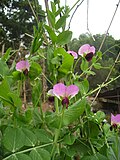| Snow pea | |
|---|---|
 | |
| Species | Pisum sativum |
| Cultivar group | Macrocarpon Group [1] |
| Cultivar group members | Many; see text. |
The snow pea (British English: mangetout [2] [3] ) is an edible-pod pea with flat pods and thin pod walls unlike snap pea pods, which are round with thick walls. [4] It is eaten whole, with both the seeds and the pod, while still unripened.



